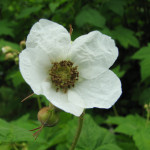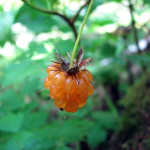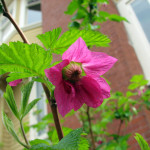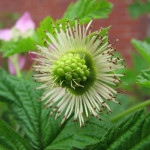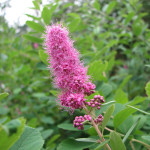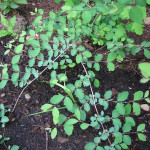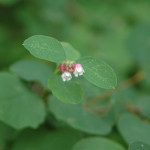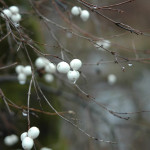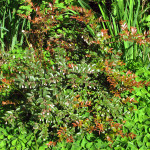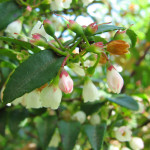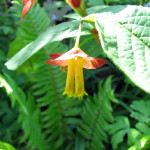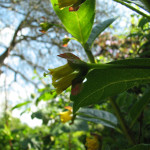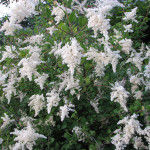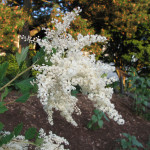Rubus parviflorus
Thimbleberry (Rubus parviflorusis) is a dense, spreading deciduous shrub that grows 4-6 feet tall and wide. It is a friendly plant with large, soft, fuzzy leaves and no thorns or prickles. The white flowers have five petals and a pale yellow center. The delicious fruits are like large, soft, velvety raspberries.
Thimbleberries are used by many kinds of wildlife year round. They are important sources of nectar, nest material, and winter shelter for native bees. Yellow-banded sphinx moths eat the leaves when young, and the berries are eaten by dozens of species.
These thicket-forming plants typically grow along roadsides, railroad tracks, and in forest clearings, commonly appearing soon after clear cuts and forest fire areas. In urban areas, thimbleberries can form a natural hedge at the back of the garden or provide cover on sunny, dry hillsides.
- Light Requirements: Full Sun, Part Shade, Full Shade
- Water Requirements: Dry, Moist
- Ease of Growing: Easy to grow
- Growth Rate: Moderate
- Spreads: Yes
- Wildlife Support: Pollinators, Hummingbirds, Pest-eating Insects, Birds or Mammals
- Fire-resistant: No
- Edible: Yes
- Mature Height: 4-6ft
- Mature Width:3-6ft
Salmonberry

Rubus spectabilis
Salmonberry (Rubus spectabilis) is an upright shrub growing to 10 feet tall, with a unique vase-like shape and prickly stems. The purple-magenta flowers bloom April through June. The orange-red, raspberry-like fruit matures in late summer to early autumn.
Salmonberry is a great wildlife plant for a large yard or garden; the open flowers attract bumblebees and hummingbirds while the fruit is a treat for thrushes, tanagers, finches, and wrens. Native bees also use it extensively for nesting material and winter shelter.
Salmonberries grow in moist forest openings and stream margins, so it does best in full sun to part shade and moist to wet soils. They often form large thickets, and thrive in the open spaces under stands of red alder.
- Light Requirements: Full Sun, Part Shade, Full Shade
- Water Requirements: Moist, Seasonally Wet
- Ease of Growing: Easy to grow
- Growth Rate: Moderate
- Spreads: Yes
- Wildlife Support: Pollinators, Hummingbirds, Pest-eating Insects, Birds or Mammals
- Fire-resistant: No
- Edible: Yes
- Mature Height: 4-10ft
- Mature Width:4-10ft
Douglas Spirea
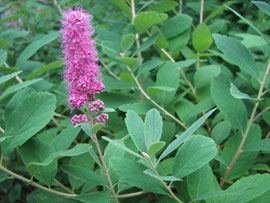
Spiraea douglasii
Also known as hardhack or steeplebush, Douglas spirea (Spiraea douglasii) is best known for its large, pink, pointy clusters of small flowers that bloom from May – July. The flower clusters turn dark in late summer and linger on the plant for months, adding visual interest.
A fast grower that can reach 10-12 feet tall in just a few years, Douglas spirea favors open sunny areas and can tolerate seasonal flooding. It can spread aggressively in moist environments, but is better behaved in drier areas.
Many butterflies visit this plant for nectar and lay their eggs on it, including pale swallowtail, Lorquin’s admiral, spring azure, and mourning cloak.
- Light Requirements: Full Sun, Part Shade
- Water Requirements: Moist, Seasonally Wet
- Ease of Growing: Easy to grow
- Growth Rate: Fast
- Spreads: Yes
- Wildlife Support: Pollinators, Pest-eating Insects, Birds or Mammals
- Fire-resistant: Yes
- Edible: No
- Mature Height: 6ft
- Mature Width:3-7ft
Snowberry
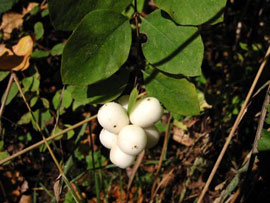
Symphoricarpos albus
Few plants are as aptly named as snowberry. Small bell-like pink flowers give way to scattered clusters of white berries in late summer, which stay on the delicate, arching branches through the fall and much of winter. The small, pale green oval leaves turn a soft yellow in the fall.
Snowberries are at their best in the landscape when combined with other plants. They bring an airy lightness to the understory that contrasts well with the thick evergreen leaves of salal and low Oregon grape, the red stems of red osier dogwoods, and the feathery green foliage of Western hemlock and Western redcedar.
The berries are eaten late in winter by thrushes, towhees, robins, waxwings, and grosbeaks. Anna’s and rufous hummingbirds are attracted to the flowers, as are many species of native bees. Snowberry also provides food for the young of vashti sphinx moths and is generally good cover for wildlife.
Snowberry is tolerant of a wide variety of growing conditions, spreads easily, and makes an excellent addition to any garden.
- Light Requirements: Full Sun, Part Shade, Full Shade
- Water Requirements: Dry, Moist
- Ease of Growing: Easy to grow
- Growth Rate: Fast
- Spreads: Yes
- Wildlife Support: Pollinators, Hummingbirds, Pest-eating Insects, Birds or Mammals
- Fire-resistant: Yes
- Edible: No
- Mature Height: 3-6ft
- Mature Width:2-4ft
Evergreen Huckleberry
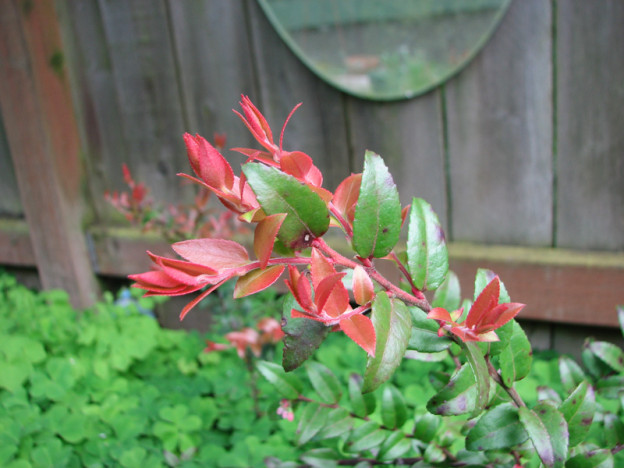
Vaccinium ovatum
Evergreen Huckleberry is a small to medium sized evergreen shrub native to the Pacific Northwest regions of the United States and British Columbia. In the Willamette Valley, it prefers full to partial shade, but will tolerate full sun in coastal areas. It grows slowly and prefers acidic soils.
The shiny, alternately arranged leaves are 2-3.0cm long and 1-1.5cm wide with finely serrated edges. In mid-summer, the plant produces round, edible black berries about 0.5 – 1.0cm in diameter. The berries are a valuable traditional food for many Native American cultures in the Pacific Northwest.
- Light Requirements: Full Sun, Part Shade, Full Shade
- Water Requirements: Moist
- Ease of Growing: Easy to grow
- Growth Rate: Slow
- Spreads: Yes
- Wildlife Support: Pollinators, Hummingbirds, Birds or Mammals
- Fire-resistant: Yes
- Edible: Yes
- Mature Height: 4-8ft
- Mature Width:3-6ft
Black Twinberry
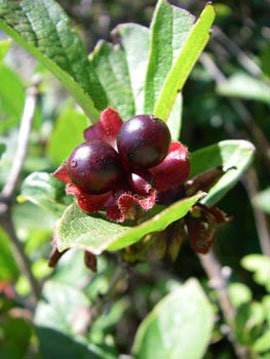
Lonicera involucrata
Black twinberry (Lonicera involucrata) is also known as “twinberry honeysuckle”. Named for its pairs of flowers and fruits, this attractive shrub grows up to 10 feet tall. Tube-shaped yellow to orange flowers bloom April – July, followed by dark purple berries surrounded by showy red bracts. Young branches have yellow bark which age to yellow-brown.
The flowers provide nectar for hummingbirds and bumblebees, and the berries are eaten by numerous birds. Twinberry is also a food plant for the young of Gillette’s Checkerspot butterfly. This wetland plant grows best in sun or partial shade and moist soil.
- Light Requirements: Full Sun, Part Shade
- Water Requirements: Moist, Seasonally Wet
- Ease of Growing: Easy to grow
- Growth Rate: Moderate
- Spreads: No
- Wildlife Support: Pollinators, Hummingbirds, Birds or Mammals
- Fire-resistant: Yes
- Edible: No
- Mature Height: 8-10ft
- Mature Width:4-10ft
Salal

Gaultheria shallon
Salal is a low-growing, leathery-leaved evergreen shrub that tolerates a wide variety of conditions. Its dark blue “berries” (actually swollen sepals) are edible raw and can be made into jams, preserves, and pies. Salal berries are mildly sweet, and are often used in combination with the more tart Oregon grape.
In the Willamette Valley, salal prefers full to partial shade. In coastal areas it can form deep, nearly impenetrable thickets, and easily tolerates full sun. It grows as far north as Baranof Island, Alaska.
Salal leaves are also harvested and sold to florists worldwide for use in floral arrangements.
- Light Requirements: Part Shade, Full Shade
- Water Requirements: Dry, Moist
- Ease of Growing: Easy to grow
- Growth Rate: Moderate
- Spreads: Yes
- Wildlife Support: Pollinators, Hummingbirds, Pest-eating Insects, Birds or Mammals
- Fire-resistant: Yes
- Edible: Yes
- Mature Height: 1-5ft
- Mature Width:1-5ft
Oceanspray
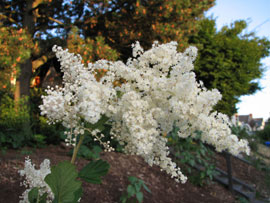
Holodiscus discolor
Oceanspray is native to western North America, most commonly found in the mountains of the Pacific Northwest. This fast-growing deciduous shrub gets 8-10′ tall and 3-7′ wide. Its small toothed leaves are 2-4 inches long. Cascading clusters of white flowers drooping from the branches give the plant two of its common names, oceanspray and creambush. The flowers have a faint sugary scent, and each one bears a small, hairy fruit containing one seed which is light enough to be dispersed by wind.
Oceanspray is found in a variety of habitats, from wet coastal forests to drier, cooler mountain peaks further inland. It often grows in areas dominated by Douglas-fir. The plant is found in areas prone to wildfire, such as chaparral communities. It is often the first green shoot to spring up in an area recovering from a burn or logging.
Many small solitary bees, bumblebees, and native butterflies visit this plant for nectar. It can also be considered a pollinator “nursery”, as pale swallowtail, spring azure, Lorquin’s admiral, and brown elfin butterflies all lay their eggs on it.
These attractive shrubs thrive on dry slopes in sun to part-sun, and spread well in favorable conditions. Long-leaf Oregon grape and salal do well in their shade, and they pair well with hazelnut to make a woodland border. Combine with red-flowering currant or vine maple for a deciduous screen.
- Light Requirements: Full Sun, Part Shade, Full Shade
- Water Requirements: Dry, Moist
- Ease of Growing: Easy to grow
- Growth Rate: Fast
- Spreads: Yes
- Wildlife Support: Pollinators, Pest-eating Insects, Birds or Mammals
- Fire-resistant: Yes
- Edible: No
- Mature Height: 8-10ft
- Mature Width:3-7ft



